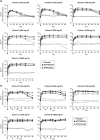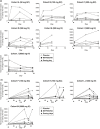Dose-dependent inactivation of airway tryptase with a novel dissociating anti-tryptase antibody (MTPS9579A) in healthy participants: A randomized trial
- PMID: 34581002
- PMCID: PMC8841439
- DOI: 10.1111/cts.13163
Dose-dependent inactivation of airway tryptase with a novel dissociating anti-tryptase antibody (MTPS9579A) in healthy participants: A randomized trial
Abstract
Tryptase is the most abundant secretory granule protein in human lung mast cells and plays an important role in asthma pathogenesis. MTPS9579A is a novel monoclonal antibody that selectively inhibits tryptase activity by dissociating active tetramers into inactive monomers. The safety, tolerability, pharmacokinetics (PKs), and systemic and airway pharmacodynamics (PDs) of MTPS9579A were assessed in healthy participants. In this phase I single-center, randomized, observer-blinded, and placebo-controlled study, single and multiple ascending doses of MTPS9579A were administered subcutaneously (s.c.) or intravenously (i.v.) in healthy participants. In addition to monitoring safety and tolerability, the concentrations of MTPS9579A, total tryptase, and active tryptase were quantified. This study included 106 healthy participants (82 on active treatment). Overall, MTPS9579A was well-tolerated with no serious or severe adverse events. Serum MTPS9579A showed a dose-proportional increase in maximum serum concentration (Cmax ) values at high doses, and a nonlinear increase in area under the curve (AUC) values at low concentrations consistent with target-mediated clearance were observed. Rapid and dose-dependent reduction in nasosorption active tryptase was observed postdose, confirming activity and the PK/PD relationship of MTPS9579A in the airway. A novel biomarker assay was used to demonstrate for the first time that an investigative antibody therapeutic (MTPS9579A) can inhibit tryptase activity in the upper airway. A favorable safety and tolerability profile supports further assessment of MTPS9579A in asthma. Understanding the exposure-response relationships using the novel PD biomarker will help inform clinical development, such as dose selection or defining patient subgroups.
© 2021 Genentech, Inc. and F. Hoffmann-La Roche AG. Clinical and Translational Science published by Wiley Periodicals LLC on behalf of the American Society for Clinical Pharmacology and Therapeutics.
Conflict of interest statement
S.M.R., S.S., G.S., M.B., K.Y., P.B., V. Sverkos, F.C., V. Steffen, L.M.H., J.G., H.R., P.N.B., J.H.L., and T.L.S are or were employees of Genentech, Inc., a member of the Roche Group, at the time this research was conducted and are Roche stockholders. J.S. was an employee of Roche at the time this research was conducted and is a Roche stockholder. S.S. is currently an employee of The Janssen Pharmaceutical Companies of Johnson & Johnson and is a stockholder of Johnson & Johnson. F.C. is currently an employee of AbbVie and is an AbbVie stockholder.
Figures





References
-
- Hallgren J, Pejler G. Biology of mast cell tryptase. An inflammatory mediator. FEBS J. 2006;273:1871‐1895. - PubMed
-
- Schwartz LB, Lewis RA, Seldin D, Austen KF. Acid hydrolases and tryptase from secretory granules of dispersed human lung mast cells. J Immunol. 1981;126:1290‐1294. - PubMed
-
- Hallgren J, Lindahl S, Pejler G. Structural requirements and mechanism for heparin‐dependent activation and tetramerization of human betaI‐ and betaII‐tryptase. J Mol Biol. 2005;345:129‐139. - PubMed
-
- Schwartz LB, Bradford TR. Regulation of tryptase from human lung mast cells by heparin. Stabilization of the active tetramer. J Biol Chem. 1986;261:7372‐7379. - PubMed
Publication types
MeSH terms
Substances
Grants and funding
LinkOut - more resources
Full Text Sources
Medical
Miscellaneous

